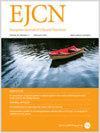Comparison of three objective nutritional screening tools for identifying GLIM-defined malnutrition in patients with gastric cancer
IF 3.6
3区 医学
Q2 NUTRITION & DIETETICS
引用次数: 0
Abstract
This study aimed to compare three objective nutritional screening tools for identifying GLIM-defined malnutrition in patients with gastric cancer (GC). Objective nutritional screening tools including geriatric nutritional risk index (GNRI), prognostic nutritional index (PNI), and controlling nutritional status (CONUT) score, were evaluated in patients with GC at our institution. Malnutrition was diagnosed according to the GLIM criteria. The diagnostic value of GNRI, PNI, and COUNT scores in identifying GLIM-defined malnutrition was assessed by conducting Receiver Operating Characteristic (ROC) curves and calculating the area under the curve (AUC). Additionally, sensitivity, specificity, accuracy, positive predictive value (PPV), and negative predictive value (NPV) were determined. The Kappa coefficient (k) was used to assess agreement between three objective nutritional screening tools and GLIM criteria. A total of 316 patients were enrolled in this study, and malnutrition was diagnosed in 151 (47.8%) patients based on the GLIM criteria. The GNRI demonstrated good diagnostic accuracy (AUC = 0.805, 95% CI: 0.758–0.852) for detecting GLIM-defined malnutrition, while the PNI and COUNT score showed poor diagnostic accuracy with AUCs of 0.699 (95% CI: 0.641–0.757) and 0.665 (95% CI: 0.605–0.725) respectively. Among these objective nutritional screening tools, the GNRI-based malnutrition risk assessment demonstrated the highest specificity (80.0%), accuracy (72.8%), PPV (74.8%), NPV (71.4%), and consistency (k = 0.452) with GLIM-defined malnutrition. Compared to PNI and COUNT scores, GNRI demonstrated superior performance as an objective nutritional screening tool for identifying GLIM-defined malnutrition in GC patients.

比较三种客观营养筛查工具,以确定胃癌患者 GLIM 定义的营养不良情况。
研究目的本研究旨在比较用于识别胃癌(GC)患者 GLIM 定义营养不良的三种客观营养筛查工具:方法:对本院胃癌患者的客观营养筛查工具进行评估,包括老年营养风险指数(GNRI)、预后营养指数(PNI)和控制营养状况(CONUT)评分。营养不良根据 GLIM 标准进行诊断。通过绘制接收者操作特征曲线(ROC)并计算曲线下面积(AUC),评估了 GNRI、PNI 和 COUNT 评分在识别 GLIM 定义的营养不良方面的诊断价值。此外,还确定了敏感性、特异性、准确性、阳性预测值 (PPV) 和阴性预测值 (NPV)。卡帕系数(k)用于评估三种客观营养筛查工具与 GLIM 标准之间的一致性:本研究共纳入 316 名患者,根据 GLIM 标准诊断出 151 名(47.8%)患者营养不良。GNRI 在检测 GLIM 定义的营养不良方面表现出良好的诊断准确性(AUC = 0.805,95% CI:0.758-0.852),而 PNI 和 COUNT 评分的诊断准确性较差,AUC 分别为 0.699(95% CI:0.641-0.757)和 0.665(95% CI:0.605-0.725)。在这些客观营养筛查工具中,基于 GNRI 的营养不良风险评估显示出最高的特异性(80.0%)、准确性(72.8%)、PPV(74.8%)、NPV(71.4%)以及与 GLIM 定义的营养不良的一致性(k = 0.452):结论:与 PNI 和 COUNT 评分相比,GNRI 作为一种客观的营养筛查工具,在识别 GC 患者 GLIM 定义的营养不良方面表现出色。
本文章由计算机程序翻译,如有差异,请以英文原文为准。
求助全文
约1分钟内获得全文
求助全文
来源期刊
CiteScore
10.60
自引率
2.10%
发文量
189
审稿时长
3-6 weeks
期刊介绍:
The European Journal of Clinical Nutrition (EJCN) is an international, peer-reviewed journal covering all aspects of human and clinical nutrition. The journal welcomes original research, reviews, case reports and brief communications based on clinical, metabolic and epidemiological studies that describe methodologies, mechanisms, associations and benefits of nutritional interventions for clinical disease and health promotion.
Topics of interest include but are not limited to:
Nutrition and Health (including climate and ecological aspects)
Metabolism & Metabolomics
Genomics and personalized strategies in nutrition
Nutrition during the early life cycle
Health issues and nutrition in the elderly
Phenotyping in clinical nutrition
Nutrition in acute and chronic diseases
The double burden of ''malnutrition'': Under-nutrition and Obesity
Prevention of Non Communicable Diseases (NCD)

 求助内容:
求助内容: 应助结果提醒方式:
应助结果提醒方式:


